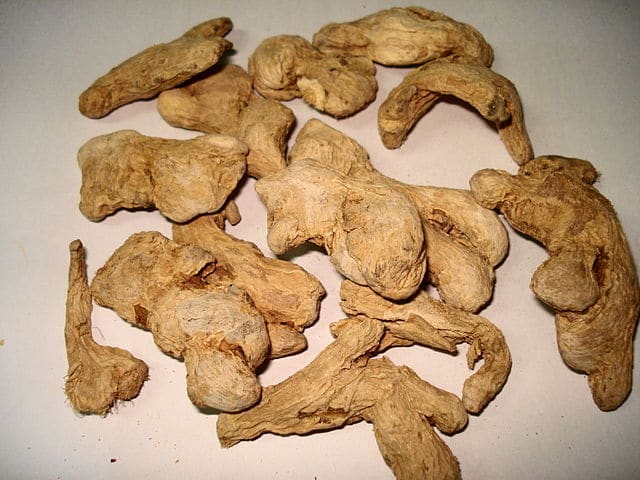Ginger:
What is it?, History, cultivation, nutritional value, uses, recipes, and more...
Ginger, also known as “kion” in Peru, is the underground stem (rhizome) of a plant that grows in most tropical climates around the world. It is characterized by its coveted place in the food industry due to its spicy flavor and its medicinal properties and applications for various health conditions.
Índice
What is Ginger?
Ginger, or “kion,” is a plant whose underground stem is a horizontal rhizome that can grow up to 2 meters in height. It has long linear leaves measuring 5 to 25 cm in length and 1 to 3 cm in width. The leaves have a pointed apex, a wedge-shaped base, are smooth (glabrous), and lack petioles.
The flowers are clustered in an inflorescence that emerges from the base of the plant. They come in different colors depending on the variety and typically have three yellowish sepals and three cherry-colored petals with light spots. The fruit is a subglobose to ellipsoid capsule with glossy black seeds and a white, lacerated aril.
Only the “hands” of the rhizome, measuring about 10 cm in length, are used from the entire plant.
History of Ginger
Ginger is believed to have originated in the Southeast Asian islands (Malaysia, Brunei, Philippines, Singapore, Indonesia, and East Timor) and could have been domesticated by Austronesian peoples around 5000 or 4000 BC. It is one of the first species exported from the East to the West. It is known to have reached Europe during the spice trade and was used by ancient Greeks and Romans.
The first written records about ginger were provided by the famous Chinese sage Confucius (551 to 479 BC). During these years, trade embassies of Persian king Darius I (549 to 486 BC) brought the spice to Persia from India.
In the 1st century, it was carried to the Mediterranean by the Phoenicians, where it became known in Egypt, Greece, and Rome simultaneously.
In the 2nd century, ginger appears in a list of imports received in Alexandria (Egypt) from the Red Sea, subject to customs duties by Rome. According to this list, ginger was the second preferred spice among the Romans, following pepper.
The Quran (Sura 76, 17) states that in the Garden of Delights, righteous Muslims, who, being dead, are not pure spirits, will find ginger to honor the houris (angelic sex slaves): “Their drink is a mixture of exquisite wines and pure water of zangebir.”
During the 9th century, ginger reached France and Germany, and a bit later, England. It was the Portuguese who introduced it to Africa, and during the 15th century, the Spanish brought it to the Antilles islands. It is also known that Francisco de Mendoza, son of Viceroy Antonio de Mendoza, planted pepper, clove, and ginger in New Spain (modern-day Mexico), with the latter yielding the best results, being considered “good for stews and aiding digestion.”

Common Name of Ginger
| Español | Kion, quion, cañacoros |
| Català | Gingebre |
| Esperanto | Tupapa supha, jopa, jupha, juira, ära, qallapi, vocal, linquiñique. |
| Inglés | Ginger |
| Euskara | Jengibre |
| Português | Genjibre |
| Français | Gingembre |
| Italiano | Gengero, Zenzero |
| Deutsch | Ingwer |
| Asturianu | Sinxebra, Xenxibre |
| Galego | Xenxibre |
Scientific Name of Ginger
Zingiber officinale
Taxonomy of Ginger
| Kingdom | Plantae |
| Division | Magnoliophyta |
| Class | Liliopsida |
| Order | Zingiberales |
| Family | Zingiberaceae |
| Subfamily | Zingiberoideae |
| Tribu | Zingibereae |
| Gender | Zingiber |
| Specie | Zingiber officinale Rosc., 1807 |
Synonyms of Ginger
- Amomum angustifolium Salisb.
- Amomum zingiber L.
- Amomum zinziba Hill
- Curcuma longifolia Wall.
- Zingiber aromaticum Noronha
- Zingiber cholmondeleyi (F.M.Bailey) K.Schum.
- Zingiber majus Rumph.
- Zingiber missionis Wall.
- Zingiber officinale var. cholmondeleyi F.M.Bailey
- Zingiber officinale f. macrorhizonum (Makino) M.Hiroe
- Zingiber officinale var. macrorhizonum Makino
- Zingiber officinale f. rubens (Makino) M.Hiroe
- Zingiber officinale var. rubens Makino
- Zingiber officinale var. rubrum Theilade
- Zingiber officinale var. sichuanense (Z.Y.Zhu, S.L.Zhang & S.X.Chen) Z.Y.Zhu, S.L.Zhang & S.X.Chen
- Zingiber sichuanense Z.Y.Zhu, S.L.Zhang & S.X.Chen
- Zingiber (L.) H.Karst.
Etymology of Ginger
The origin of the word “ginger” comes from medieval Latin “zingĭber, -ibĕris,” which comes from Greek “ζιγγίβερις” (zingíberis), and this in turn from Prakrit “singavera.” “Singavera” itself comes from Sanskrit “srngaveram,” where “srngam” means “horn” and “vera” means “body,” referring to the shape of its root. In other words, it means “body of horn.”
Habitat of Ginger
- Habitat
Ginger cultivation requires a warm tropical or subtropical climate with temperatures between 25 and 30°C and an annual rainfall of over 2,000 mm, distributed throughout the year, as it cannot tolerate periods of drought. The most suitable soils for its development are alluvial, loose, with high organic matter content, easy to cultivate, and well-drained. Another important characteristic of the land, in the case of large-scale cultivation, is that it allows for mechanization.
Harvesting occurs nine to ten months after planting.
Geographical Distribution of Ginger

Loreto, Junín, Tacna
Seasonal Availability of Ginger
- It is available throughout the year.
Varieties of Ginger
There are two classes of ginger:
-
At the national level
Zingiber officinale (common ginger) and Zingiber serumber (wild ginger).
Nutritional Value of Ginger
Ginger is rich in nutrients and bioactive compounds that have powerful benefits for the body and brain. Some of the key ones include:
- It contains gingerol, which has potent anti-inflammatory and antioxidant effects.
- Just 1 to 1.5 grams of ginger can help prevent various types of nausea, including chemotherapy-induced nausea, post-surgery nausea, and morning sickness.
- According to studies in animals and humans, ginger can help with weight loss, both in terms of body weight and waist-to-hip ratio.
- It is effective in reducing symptoms of osteoarthritis, especially knee osteoarthritis.
- It lowers blood sugar levels and improves various risk factors for heart disease in people with type 2 diabetes.
- It can help treat chronic indigestion by speeding up stomach emptying.
- It can significantly reduce menstrual pain.
- It significantly reduces levels of LDL (bad) cholesterol, total cholesterol, and blood triglycerides.
- It appears to have protective effects against cancer.
- However, more research is needed in this regard. It can improve brain function and protect against Alzheimer’s disease.
- It can help fight infections.
Health Benefits of Ginger
Ginger is a powerful natural anti-inflammatory, possesses antioxidant properties, and has a high content of phenolic compounds. Additionally, it contains vitamin C, B2, B3, iron, phosphorus, and calcium.
Contraindications or Side Effects
Natural ginger is safe for most people and has few known potential side effects. Some of these include:
- Gastritis, diarrhea, and/or heartburn.
- It slows down blood clotting, so caution should be exercised if taking medications that also have this effect, such as warfarin, ibuprofen, or aspirin, or around the time of surgery.
- Caution is advised for diabetic individuals, as it might necessitate adjusting insulin dosage.
- It should be avoided if the person is undergoing treatment for high blood pressure.
- People with gallstones, digestive ulcers, or thyroid issues should also avoid ginger.
- Its use is not recommended for pregnant women, children, and breastfeeding women until more studies are conducted to establish its safety during these vital phases.
| 10 Porciones por Kilogramo | |
| Tamaño de porción | 100g |
| Cantidad por porción Calorías |
434 |
| Cantidad por 100g | |
| Energía | 1,814 kJ |
| Grasa Total | 12.7 g |
| Sodio | ● |
| Carbohidratos totales | 74.9 g |
| Carbohidratos disponibles | 73.8 g |
| Fibra Dietaria | 1.1 g |
| Proteínas | 6.0 g |
| Calcio | 22 mg |
| Fósforo | 665 mg |
| Zinc | 0.64 mg |
| Hierro | 0.60 mg |
| Potasio | ● |
| Agua | 4.8 g |
| Cenizas | 1.6 g |
| Vitamina A | 0 μg |
| Tiamina (B1) | 0.04 mg |
| Riboflavina (B2) | 0.04 mg |
| Niacina (B3) | 0.50 mg |
| Vitamina C | 0.00 mg |
| Acido Fólico (B9) | ● |
| β-Caroteno | ● |
| Fuente: Tablas peruanas de composición de alimentos – Centro Nacional de Alimentación y Nutrición – Ministerio de Salud – Perú | |
Derived Products and Consumption Methods of Ginger
Uses of Ginger
Ginger is an excellent culinary ingredient that complements its nutritional and medicinal properties perfectly.
- Culinary
- Medicinal
- Industrial
Culinary Use of Ginger
Ginger can be used as an ingredient by cooking, grating, pickling, or even consuming it raw. One of the most common ways to ingest it is in beverages like infusions, although it can be used as a spice and added to sauces, dishes, drinks, and much more.
Ginger possesses a distinctive perfumed aroma, and its flavor is spicy, pungent, and penetrating, with a slightly sweet note.
These rhizomes are used in most kitchens worldwide, particularly in Asian cuisine. They are often pickled as an appetizer or added as an ingredient to many dishes. Mature roots are fibrous, dried, and their juice is spicy, which makes them a popular spice in Chinese cuisine to mask other stronger aromas and flavors, such as seafood and lamb.
In Western cuisine, dried or powdered ginger is mostly limited to sweet foods. It's used to make candies, gingerbread, the main flavoring for ginger ale, hot beverages, and more.
When buying fresh ginger, it's important to choose a root with smooth skin and a spicy aroma. It is recommended to store it in a plastic bag in the refrigerator or freezer.
Medicinal Use of Ginger
Historically, records show that Galen used ginger as a remedy to correct tumors, bodily defects, and in treatments for paralysis caused by excess phlegm. Avicenna, a renowned Muslim physician, recommended it as an aphrodisiac.
It has been proven that ginger root is effective against motion sickness-induced nausea, as well as nausea during pregnancy. A decoction of this rhizome is used to treat gastrointestinal disorders (colic, diarrhea, lack of appetite, indigestion, flatulence, nausea), and respiratory issues (tonsillitis, asthma, bronchitis, cold, fever, flu, throat inflammation, pleurisy, pneumonia, cold, hoarseness, cough, whooping cough), malaria, gout, dysmenorrhea, and rheumatism.
Topically, ginger root poultices and ointments are applied for menstrual cramps, headaches, toothaches, indurations, inflammations, tumors, rheumatism, ulcers, and even cancer.
Ginger juice is often used for massages on children as a tonic.
In summary, ginger is attributed with aphrodisiac, analgesic, antihistamine, antiseptic, antitussive, appetizer, aromatic, astringent, carminative, diaphoretic, digestive, expectorant, rubefacient, sudorific, and tonic properties.
Industrial Use of Ginger
In Western herbal medicine, ginger is commercialized as tablets, capsules, and syrups. Ginger oil is also used as an essence in the cosmetics and perfumery industry.
Ginger is used in the formulation of various mouthwashes, toothpastes, and dental medications, and there's a carbonated beverage based on this root: ginger ale. Ginger Ale is a popular yeast-based soda that is non-alcoholic.



